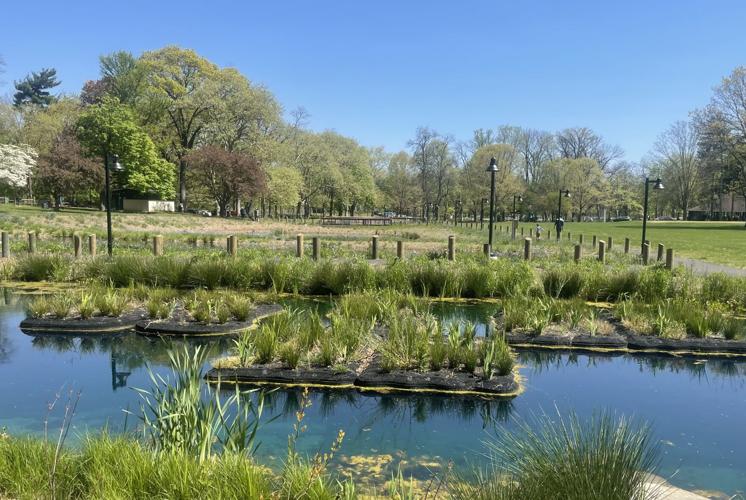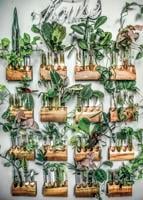While the vibe at the wetlands in Long’s Park is not quite on the level of a Claude Monet painting, hints of similarity shine as a shimmering dragonfly deftly maneuvers around dainty blue blooms and heads out over lily pads and water.
“With this being a very heavily used public park, aesthetics were definitely a consideration,” says Kate Austin, green infrastructure coordinator for the City of Lancaster. “But the driver behind this was water quality.”
Construction wrapped last summer on the city’s $1.94 million wetlands project that was six years in the works. Five basins now filter stormwater from nearby Route 30 and tackle runoff from Long’s Park itself and water pumped up from Long’s Pond.
Of course, while it is practical, there’s still beauty in the wetlands.
“It has been of interest to the plant people in the community because it’s kind of a different sort of landscape,” Austin says. “And one of the things we’re hoping to do with future signage is to have some more information about the plants that are out here.”
Here are 10 things to know about what you might see there.
READ: Long's Park Summer Music Series 2024: Here's the lineup for the free, outdoor summer concert series
Much of the color comes from a mix.
A lot of what visitors will notice blooming on the upland areas around the basins comes from a seed mix from Ernst Seeds in Meadville. Ernst, which calls itself the largest producer and supplier of native seeds on the East Coast, offers mixes formulated for everything from reducing mine runoff to supporting sheep grazing and pollinators flying among solar arrays. For the wetlands, the city went with Ernst’s low-growing wildflower and low-grass mix, which Ernst advertises as providing “erosion and sediment control and color on low-fertility sites.”
Why is the wetland soil not so hot? That area used to be a big, open grass field used as overflow parking for large events. Mowers and lots of cars packed the soil down, Austin says. As plants now grow and die and add nutrients back into the ground, that could change.
“I think all of this will improve and get a lot healthier over time,” she says.

Aromatic aster seeds were among those that came in the mix the city bought from Ernst Seeds in Meadville to plant on the uplands at Long’s Park. Here the asters bloom at the wetlands in September 2023. It’s the longest blooming of the native asters and has a lemony scent, according to Ernst.
There’s a lot in that mix.
Ernst says the mix used there includes fescue; annual ryegrass; sideoats grama (a bunchgrass often used in upland meadows); perennial blue flax; cornflower; lanceleaf coreopsis; perennial gaillardia (also known as blanket flower); black-eyed Susans, annual gaillardia (also known as Indian blanket); shasta daisies; golden alexanders; aromatic aster, butterfly milkweed; corn poppy; narrowleaf mountain mint; common yarrow; anise; and hairy beardtongue.

Spring color is just starting to show up in the wetlands at Long’s Park, a project completed last summer. Here perennial blue flax mirrors the sky above on a late-April afternoon.
Bloom times are staggered.
The blue flax and cornflowers were blooming as of last Friday. Visitors will have to wait until later in the spring and summer for blooms like black-eyed Susans, one of Austin’s favorites.
“We use those frequently in our rain gardens in the city — the smaller bump-outs on the sides of the road,” she says. “They can tolerate some shade. They can tolerate some moisture. They don’t like to be in standing water. But they’re pretty flexible.”
Those floating plant islands are lighter than you might think.
Austin says the man-made islands in the floating wetlands pond are relatively light. But you’ll have to take her word for it. The islands are anchored by chains.
They look a little like floating patches of asphalt, but the surface is actually rubbery, Austin says. Each one has several holes. The plant goes on top. The roots grow down through the holes into the water. The idea is to get as many plants working that basin as possible because that’s where runoff first comes in from Route 30.
“It comes in with all kind of things to address,” Austin says. “We want to have a lot of plant matter to absorb any pollutants.”
Here’s where to find the wetlands.
Come in the main Long’s Park entrance and drive past the pond, heading up the hill and keeping right. You can’t miss the wetlands if you park in the shadow of the massive, electronic Route 30 billboard.
Don’t pick up those sticks.
The sticks stuck into the ground on the banks may look like something to throw for Fido. But they’ve been cut at an angle and stuck in there intentionally with the idea they’ll take root in an area for which plant selection was done carefully.
“We specifically picked ones that can handle being totally flooded and can handle it when the water recedes and they’re dry again,” Austin says. “So things like red-osier dogwood, gray dogwood, silky dogwood and black willow.”
Sometimes cattails just choose you.
The cattails growing in the lower marsh weren’t planted on purpose.
“They just showed up,” Austin says, adding birds are the likely culprits. “They can be more of an aggressive grower. So we’re pulling (some of) them because we don’t want them to totally take over.”
There are native and non-native cattails in the wetlands. Of the 30 species of cattails found worldwide, three are in North America, with one of them being a non-native likely introduced to the East Coast from Europe during the mid-1800s, according to a National Parks Service primer. That reports that a hybrid of at least two of the three is considered invasive.
“They’re very difficult to tell the difference between,” Austin says. “That’s one of the challenges.”

Pickerel weed was a must have for the Long’s Park wetlands, says Kate Austin, green infrastructure coordinator for the City of Lancaster. Their 2024 leaves are just starting to come out. Visitors will have to wait until later this summer to see them blooming like they were in September, shown here.
Most plants growing down in the water were invited.
Among the plants purposely planted on the bottom of the basins is pickerel weed.
“This is a native species perfectly suited to being completely submerged in water,” Austin says. “They have beautiful flowers on them. So they’re great for pollinators and they’re doing a really important job of helping to clarify the water in there.”
There’s arum there, too. Said to be a low-maintenance plant, it boasts broad, arrow-shaped leaves.
Austin says those were all planted on the basin bottoms before any water was introduced. And city employees can lower the basin levels if a replant is ever needed, she says. Trying something similar at home in a pond would likely involve waders, she says.
Sedges and rushes abound.
Some sedges and rushes are already green. The ones on the bottom of the basin filled with iron-enhanced sand (there to pull out phosphorus and nitrogen) were looking rather brown as of Friday. Those should green up soon, Austin says.
“I’m keeping my eye on them,” she says.
Austin runs her fingers along a rush. It feels more solid than grass and is smooth to the touch. How do you tell the difference? There are exceptions to the following, but this saying gets thrown around a lot among plant people: “Sedges have edges. Rushes are round. Grasses have nodes from the top to the ground.”
You can whip out an iPhone if you don’t recognize something.
Austin did use her phone when she was blanking on the name of the shrub growing out of one of those aforementioned sticks.
“I love showing people one of my favorite tricks,” Austin says after taking a picture and then clicking on the “i” symbol below it. She says she’s found that to be more accurate than some of the plant-identification apps that cost money.
“Ah, sumac,” she says.
That’s growing not far from an itea. Also known as Virginia sweetspire, the bush with white bottlebrush flowers is one of the Penn State Extension Service’s suggestions for replacing an invasive species called Japanese barberry.
“This itea is just starting to leaf out,” Austin says. “It flowers beautifully. It’s a great landscape shrub. It’s pretty, the butterflies love it … and it smells great, too.”









 ERIN NEGLEY | Staff Writer
ERIN NEGLEY | Staff Writer


